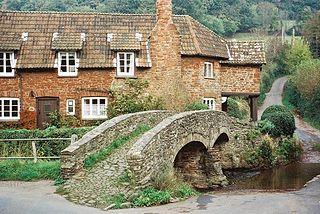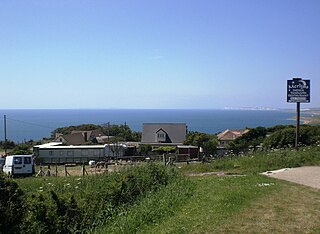
Shanklin is a popular seaside resort and civil parish on the Isle of Wight, England, located on Sandown Bay. Shanklin is the southernmost of three settlements which occupy the bay, and is close to Lake and Sandown. The sandy beach, its Old Village and a wooded ravine, Shanklin Chine, are its main attractions. The esplanade along the beach is occupied by hotels and restaurants for the most part, and is one of the most tourist-oriented parts of the town. The other is the Old Village, at the top of Shanklin Chine.
Together with Lake and Sandown to the north, Shanklin forms a built up area of 21,374 inhabitants (2011).
A combe can refer either to a steep, narrow valley, or to a small valley or large hollow on the side of a hill; in any case, it is often understood simply to mean a small valley through which a watercourse does not run. The word "combe" derives from Old English cumb, of the same meaning, and is unrelated to the English word "comb". It derives ultimately from the same Brythonic source as the Welsh cwm, which has the same meaning. Today, the word is used mostly in reference to the combes of southern
and southwestern England, of Wales, and of County Kerry in Ireland.

Sandown Bay is a broad open bay which stretches for much of the length of the Isle of Wight's southeastern coast. It extends 8 1⁄2 miles (13.7 km) from Culver Down and Yaverland in the northeast to just south of Shanklin in the southwest, near the village of Luccombe. Near Luccombe, the bay is separated from The Undercliff by a large headland from which Upper Ventnor sits atop. The towns of Shanklin, Lake and Sandown are located on the bay's coast, while Luccombe and Upper Ventnor feature panoramic views across both Sandown Bay to the East and the Undercliff to the southwest. Due to the bay being relatively sheltered from offshore winds it is often used as temporary anchorage point for boats, including large cargo ships, before continuing east towards Continental Europe, or north towards The Solent.

St Boniface Down is a chalk down on the Isle of Wight, England. It is located close to the town of Ventnor, in the southeast of the Island, and rises to 241 metres (791 ft), the Island's highest point, 1 kilometre (0.6 mi) north of the town. There is reputed to be a wishing well on its southern slope, which requires the wisher to climb up from the south without looking back.
In 1545 a French invasion force attempted this against a force of the Isle of Wight Militia commanded by Sir John Fyssher- which allegedly included several women archers- and were routed.
In 1940 the radar station was bombed by Ju 87 Stuka dive bombers, which is reconstructed in the film "The Battle of Britain". The top is surmounted by a round barrow.

Allerford is a village in the county of Somerset, England, located within Exmoor National Park, and is part of the parish of Selworthy in the district of West Somerset. It appears in Domesday Book as “Alresford – forda Ralph de Limesy Mill”.

Blackgang is a village on the south-western coast of the Isle of Wight. It is best known as the location of the Blackgang Chine amusement park which sits to the south of St Catherine's Down.

The River Horner, also known as Horner Water, rises near Luccombe on Exmoor, Somerset, and flows past Porlock into Porlock Bay near Hurlstone Point on the Bristol Channel.

Sweetworthy is the site of two Iron Age hill forts or enclosures at Luccombe, 4 kilometres (2 mi) south of Porlock, Somerset, England. They are on the north-facing slope of Dunkery Hill. One has a single rampart and external ditch, enclosing 0.25 hectares. The rampart is still visible and the ditch on the east side is used as a trackway. There was a defended settlement above the main site.

Luccombe Chine is a geological feature and visitor attraction south of the village of Luccombe on the Isle of Wight, England. A wooded coastal ravine, one of a number of such chines on the island created by stream erosion of soft Cretaceous rocks, it leads from the clifftop to Luccombe Bay.

Luccombe Bay is a bay on the south-east coast of the Isle of Wight, England. It lies to the east of Luccombe Village from which it takes its name. It faces south-east towards the English Channel, its shoreline is 2⁄3 mile (1.1 km) in length. It consists of a predominantly sand and shingle beach lined with sea cliffs which range from 200 to 280 feet in height. It stretches from Horse Ledge in the north to Bordwood Ledge in the south. The sea bottom is a mixture of mud and rocks.

The parish Church of St Mary in Luccombe, Somerset, England has a chancel dating from about 1300, with the nave and tower being added around 1450. It has been designated as a grade I listed building.
Williton was a rural district in Somerset, England, from 1894 to 1974.

St Albans Cathedral Choir is an English Cathedral Choir based in St Albans, Hertfordshire, England. It is made up of around 20 boy choristers aged 7–14 and 12 adult lay clerks. In 2003 it appeared in the coronation scene of the film Johnny English.
In addition to the original boys-only choir, there is also the St Albans Abbey Girls' Choir founded in 1996.
The Hundred of Carhampton is one of the 40 historical Hundreds in the ceremonial county of Somerset, England, dating from before the Norman conquest during the Anglo-Saxon era although exact dates are unknown. Each hundred had a 'fyrd', which acted as the local defence force and a court which was responsible for the maintenance of the frankpledge system. They also formed a unit for the collection of taxes. The role of the hundred court was described in the Dooms (laws) of King Edgar. The name of the hundred was normally that of its meeting-place.

Cycadeoidea is an extinct genus of bennettitalean plants known from fossil finds in North America and Europe. They lived during the Jurassic and Cretaceous periods.
John Flamank or Flamoke, of Boscarne, near Bodmin, Cornwall, was an English politician.
Luccombe Manor was a manor house on the Isle of Wight, situated in the parish of Bonchurch.

The Chink is a scenic rock cleft between Bonchurch and Luccombe, Isle of Wight, with steps descending from St Boniface Down to the Bonchurch Landslips below.














